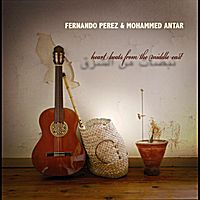Fretless guitar is the most ideal type of guitar if you want to learn what we call Maqam music on a guitar. This music system known as Maqam in the Arab countries, Makam in Turkey or even Magam for Kurdish musicians is the foundation for Middle Eastern music.
The reason why a fretless guitar is better than any other is because for this style of music we use microtones. Microtones are small divisions of a tone, even smaller than half tones. There are other options to get microtones going on your guitar but in Maqam music the golden rule is plenty of modulation. We will be switching from one maqam to another quite often and that means having all the possible microtones available at once. In other microtonal guitar options like added frets, fretlets, etc, we have a fixed set up with only certain microtones previously to performance chosen. So it is possible to play maqam music on guitar with these other options but to enjoy the real feel of a Middle Eastern musician with its traditional instrument we should stick to fretless guitar.
If you want to enjoy Arabic music played on a fretless guitar you can check out my CD "Hearbeats from the Middle East".
In it you will find solo pieces as well as compositions accompanied by Arabic traditional instruments like Ney, Arabic Accordion, Bendir, Tabla (Darbuka in Turkish), etc. All of it featuring a fretless guitar playing the parts of what would be the Arabic oud.
PLAYING ARABIC MUSIC ON FRETLESS GUITAR
In this article we will focus more on the left hand. How to place the fingers in order to get the exact pitch of a note in a fretless guitar. The right hand will be the subject of another article. For now just know that you can use a pick same as Arabic Oud players. Although my favourite is playing only with the right hand thumb using the alzapua technique usually found in Flamenco guitar. Using your thumb on a fretless guitar with nylon or carbone strings will give you a very full sound with lots of colours available.
HOW TO USE YOUR LEFT HAND WHEN PLAYING FRETLESS GUITAR
The use of the left hand when playing fretless guitar is quite similar as doing it in the standard guitar. Many people when they find out they will have to play microtones for Arabic music seen to get afraid and thrown off from trying the style. But even if it sounds like many hours of practicing the truth is far from that. Understanding how things work on the fretless guitar will have you playing Arabic as well as other fretless styles in no time. The trick is not practicing endless hours in order to place your finger on the right spot. It is about knowing what finger is best for what and this comes not from memorizing the choices but understanding why fingers work the way they do.
First important rule is to keep your left hand thumb in a good position. Always centered in the neck, never showing up from the top of the fingerboard. This proper anchoring of the thumb will help us feel secure in our finger moves as well as tuning accurately. When we play on a standard guitar we have a margin of mistakes we can do still being able to play and sound good. This is due to the existence of frets on the fingerboard. The tuning of notes comes from them, it is fixed. But in a fretless guitar it comes from the tip of the fingers themselves. So every time we make a wrong move of the thumb our fingertips will shift and the pitch of the notes will change.
But let's not make things complicate by talking about them and instead get the hang of it by practicing. First we will play the natural notes in the tempered tuning as we already know them. Make sure you place your fingertips on the fret-marks and never behind.
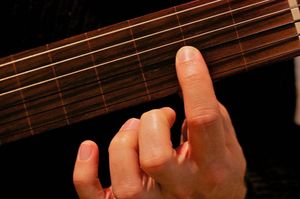
It is important that you follow the finger indications in the examples even if you see it possible to play certain notes with other fingers. This will be specially important later on when we start playing microtones. If you don't follow this it will be more difficult or even imposible later when you try to play the "real Arabic stuff".
We will start playing an exercise based on one of the guitar tunings we use in the fretless guitar in order to get closer to the Arabic oud. You could play Arabic music using the standard guitar tuning but this would make it more difficult. The standard guitar tuning is less fluent for Arabic music. Ornaments don’t flow so easily and notes don't ring the same. The Oud tuning on a guitar is richer for this music. It has more harmonics and that makes the instrument ring very nicely.
So our first Oud tuning for guitar is FADGCF.
Let’s get familiar with the notes on this tuning. I am including some directions for the thumb or pick as well.
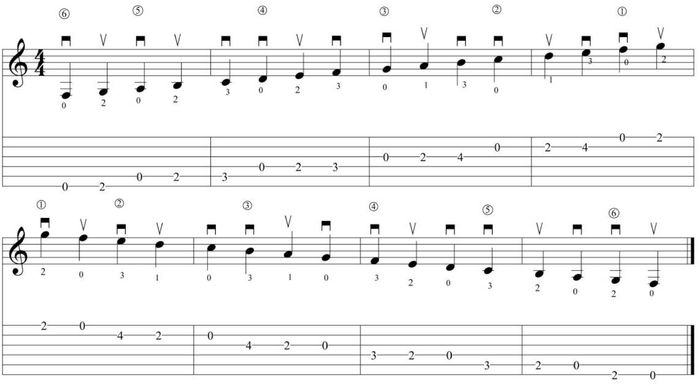
THE ARABIC MUSIC NOTES WHEN PLAYING GUITAR
Before we continue further let's make a break to explain something simple but important about Arabic music, the name of the notes.
Arabic music uses different names for its available notes. Although many Arabic players know the names in English (ABCDEFG) or the European classical names (Do, Re Mi, Fa, Sol, La, Si) it is more useful to learn the proper Arabic names.
First reason for this is the number of notes available, many of them don't exists in Western music so we need a name to refer to them. Second, many of the Maqamat (plural of Maqam) used in this music have their origin and behaviour based on certain notes. In order to learn faster and understand this better is very useful if you become familiar with these names.
This said, let's continue with the first true Arabic sounds for the guitar, the microtones.
MICROTONES ON GUITAR
Now we are going to learn how to play microtones. We will start playing a note called in Arabic Sikka. This note is a kind of E on the fourth string whose pitch is between natural and flat. The name Sikka belongs only to this pitch and it does not mean every E will be called like that.
To find the sound of this new pitch play F on the fourth string with the third finger.
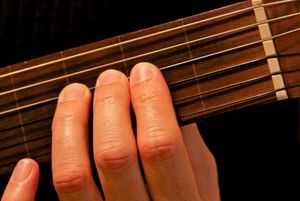
Now keeping it on the fingerboard prepare your first finger to play Eb on the first fret but instead of reaching on the first fret mark, fall short in the gap between the second and first frets. There is your Sikka.

You will notice that the same note could be reached by the second finger. This is true but as you play faster and more fluent it will be more difficult to fall in the right place using the second finger. What happens is that using the first finger it leaves the second between first and third creating a barrier so they can not get too close to each other. Hence when the first finger falls into the guitar fretboard it can not reach the natural E. It falls displaced a little lower and finds the Sikka sound.
It is important to mention that many microtones like Sikka are not always tuned in the same pitch. Depending on the maqam played they slightly shift. This small variation of pitch is better learned by listening than trying to explain every single situation.
Many microtones like this Sikka note will seen to sound out of tune to us now, but don't worry because that is what we are looking for. As we put it in context it will become the sweetest sound of all.
Try now playing Sikka. notice how we use an inverted flat sign to indicate the microtone.

MAQAM USHSHAQ TURKI ON GUITAR
Let’s learn the notes of maqam Ushshaq Turki on guitar. This maqam is known in Turkish music as Ushshaq. I am including here a couple of brakets to indicate the two groups of notes that form the maqam as well as the names by what they are known and the ghamaz note which is where they connect.

HOW TO PLAY AN ARABIC SONG ON GUITAR
And let’s finish learning how to play an Arabic composition on guitar with a few bars of a beautiful and intriguing piece composed on maqam Ushshaq Turki.
We are going to be using a second Out tuning. It is exactly like the first one I mentioned earlier but we will drop the sixth string down to D.
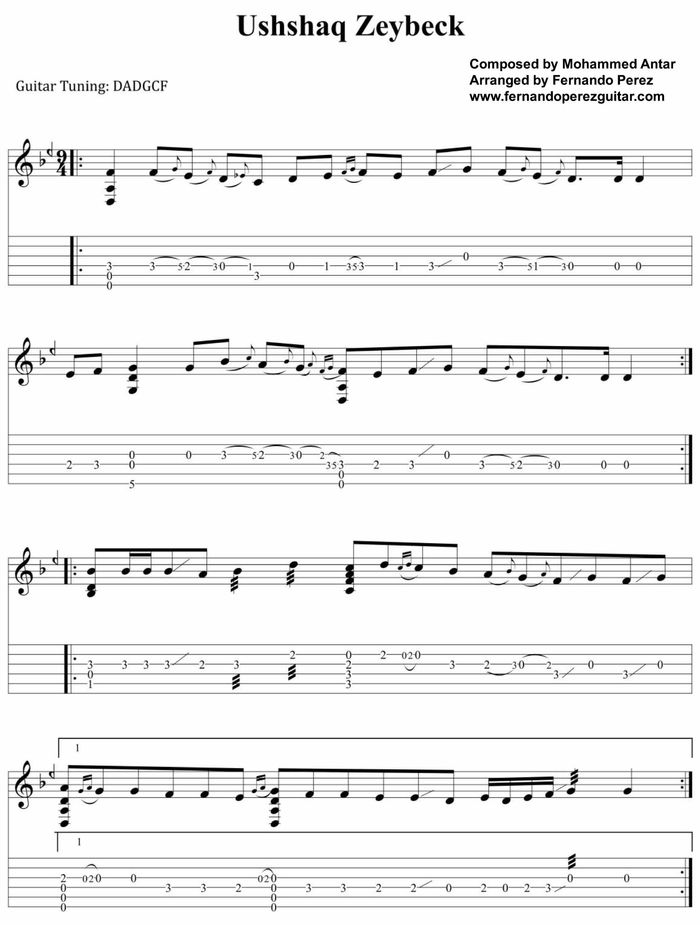
In the following video you can listen to Ushshaq Zeybeck performed on fretless guitar, ney and percussions.
If you are interested in learning more about fretless guitar techniques and also how to apply it to Arabic music I recommend you my book “Arabic Music for Fretless Guitar”.
In it you will find lots of right and left hand technique exercises with explanations. These are helpful not only for Arabic music but for playing fretless guitar in general.
Some of these techniques are unique to Arabic music and very inspiring to try in other styles. The book also features many explanations as well as exercises and compositions to understand and play Arabic maqam music on guitar.

